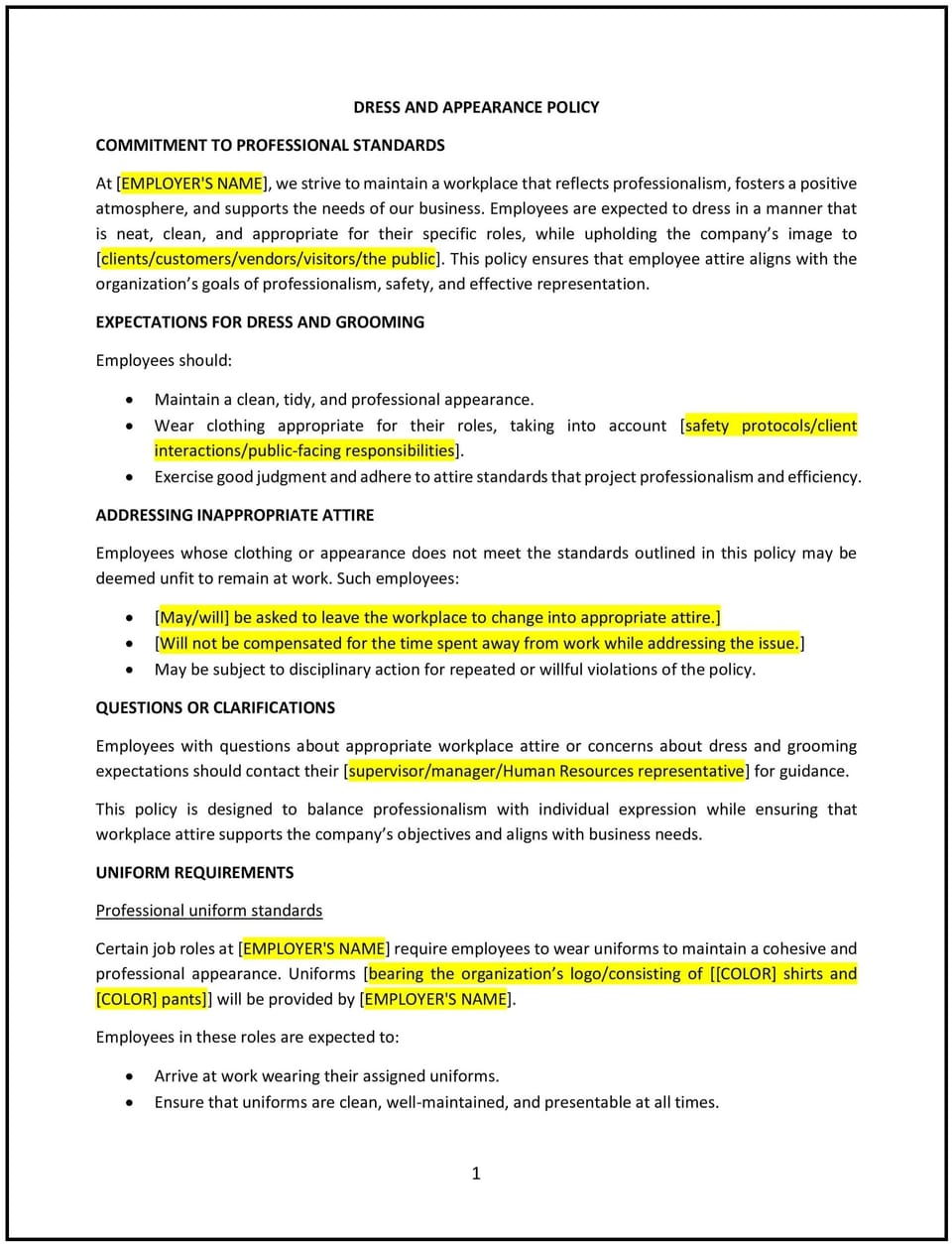Dress and appearance policy (Florida): Free template

Dress and appearance policy (Florida)
A dress and appearance policy helps Florida businesses maintain a professional, respectful, and inclusive environment by outlining the company’s expectations for employee attire and grooming. This policy provides guidelines for appropriate clothing, personal grooming, and overall appearance, considering the nature of the business and the roles employees hold. It is designed to ensure that employees present themselves in a manner consistent with the company’s image and values while allowing flexibility for individual expression and comfort.
By implementing this policy, businesses can foster a professional atmosphere, promote inclusivity, and avoid potential discrimination or misunderstandings related to appearance and dress codes.
How to use this dress and appearance policy (Florida)
- Define acceptable attire: Clearly outline what constitutes appropriate clothing in the workplace, such as business casual, formal business attire, or uniforms, depending on the company’s industry and work environment. Specify any clothing or accessories that are unacceptable, such as clothing with offensive logos, slogans, or excessively casual attire (e.g., flip-flops, ripped jeans).
- Consider job roles and work settings: Tailor the policy to account for different job roles within the company. For example, employees who interact with clients or customers may be expected to adhere to a more formal dress code, while those in non-customer-facing roles may have more flexibility.
- Set grooming standards: Specify any grooming standards related to hair, facial hair, nails, tattoos, piercings, or personal hygiene. Ensure that the standards are non-discriminatory and inclusive of different cultural, religious, and personal preferences.
- Address inclusivity and cultural considerations: Ensure the policy allows for flexibility to accommodate employees’ cultural, religious, or gender identity-related needs. For example, consider allowing religious attire (e.g., hijabs, turbans) or accommodating medical conditions that may affect grooming or dress.
- Communicate exceptions and flexibility: Clearly explain any exceptions to the dress code, such as for employees with disabilities, religious dress requirements, or in cases of extreme weather conditions. Make it clear that employees are encouraged to seek accommodations if needed.
- Provide enforcement guidelines: Outline the process for addressing violations of the dress and appearance policy. This may include a verbal or written warning, guidance on improving appearance, or further disciplinary actions if the violation persists.
Benefits of using this dress and appearance policy (Florida)
This policy offers several benefits for Florida businesses:
- Promotes professionalism: By setting clear expectations for dress and appearance, businesses ensure that employees present themselves in a professional manner that reflects positively on the company.
- Enhances company image: A consistent dress code helps create a cohesive image for the company, which can improve customer and client perceptions and strengthen the brand’s reputation.
- Encourages inclusivity: A well-structured dress code allows for flexibility to accommodate diverse cultural, religious, and personal preferences, promoting an inclusive and respectful work environment.
- Reduces confusion: Clear guidelines help prevent misunderstandings or confusion about what is appropriate to wear at work, creating a consistent and fair approach to attire across the organization.
- Avoids discrimination: By being mindful of different cultural or personal preferences, the policy can help businesses avoid potential claims of discrimination related to appearance or dress code enforcement.
Tips for using this dress and appearance policy (Florida)
- Communicate the policy clearly: Ensure all employees understand the policy, including the guidelines for appropriate attire, grooming standards, and any flexibility or exceptions available.
- Provide examples: Use specific examples of acceptable and unacceptable attire to help employees better understand the policy’s expectations.
- Review periodically: Regularly review the policy to ensure it aligns with any changes in Florida laws, company culture, or industry trends, and adjust as necessary to maintain inclusivity and relevance.
- Be consistent: Apply the policy consistently across all employees and job roles to avoid any perception of favoritism or discrimination.
- Handle violations discreetly: When addressing policy violations, handle the situation privately and respectfully to maintain employee dignity and avoid embarrassment.
Q: Why is a dress and appearance policy important for my business?
A: This policy helps maintain a professional environment, promotes a positive company image, and ensures that all employees are aware of the expectations regarding attire and grooming. It also helps avoid potential misunderstandings or conflicts over dress code.
Q: What types of clothing are acceptable in the workplace?
A: The policy should define what constitutes appropriate attire, which may vary depending on the business’s industry and job roles. For example, business casual may be appropriate in office settings, while formal attire may be expected for client-facing employees.
Q: Are there any exceptions to the dress code for cultural or religious reasons?
A: Yes, the policy should include provisions to accommodate cultural, religious, and gender identity-related needs. For example, religious head coverings, such as hijabs or turbans, should be allowed, and employees with disabilities may require accommodations in grooming or attire.
Q: How will violations of the dress code be handled?
A: The policy should specify the steps for addressing violations of the dress code, which may involve a verbal or written warning, a discussion with the employee about how to improve appearance, or further disciplinary actions for repeated violations.
Q: How should employees request accommodations for dress code-related issues?
A: Employees who need accommodations for dress code-related issues due to a medical condition, religious beliefs, or other personal reasons should be encouraged to speak with HR or their supervisor. The company should be open to making reasonable accommodations wherever possible.
Q: How often should this policy be reviewed?
A: This policy should be reviewed periodically, at least annually, to ensure that it remains relevant and aligned with Florida state laws, company culture, and industry standards. It should also be updated as needed to ensure inclusivity and address new workplace trends.
This article contains general legal information and does not contain legal advice. Cobrief is not a law firm or a substitute for an attorney or law firm. The law is complex and changes often. For legal advice, please ask a lawyer.


